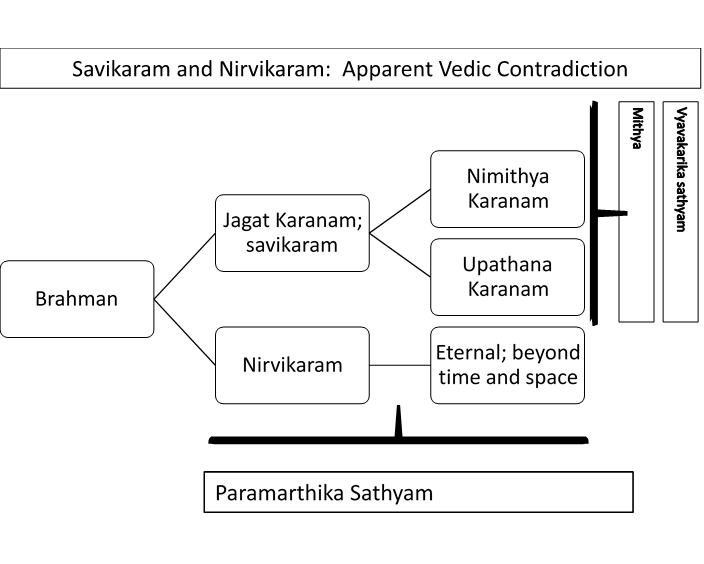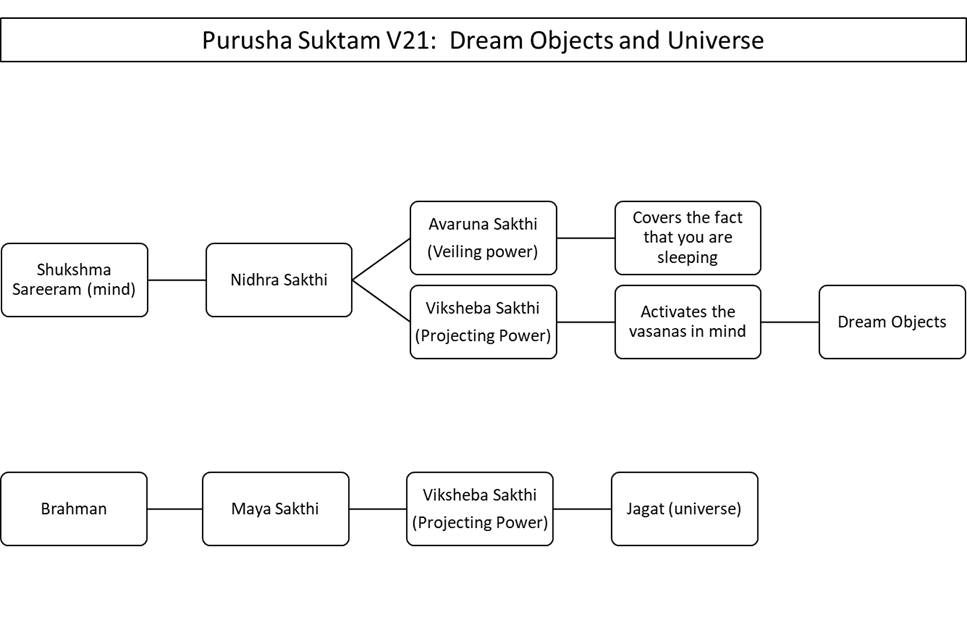Mandukya Upanishad, Class 41
While studying the nature of Brahman, we face a peculiar problem and that problem is some of the features of Brahman are contradictory to one another. Main contradiction is in the description of Brahman as nirvikaram and jagat karanam. The word nirivkaram means not subject to change; The same Upanishad also calls Brahman as upadhana karanam or material cause. Any material cause produces an effect only by undergoing modification. Examples: Seed to tree, milk to curt, gold to chain. If Brahman is nirvikaram he can’t be Jagat Karanam. As both attributes are given by the same Veda and we can’t ignore this contradiction. We have to accept and assimilate the contradiction. If two opposite attributes remain in one and the same substance, then one must be real attribute and the other unreal; one is higher order and the other is lower order. In dream we travel in train, while laying still in bed. This is possible because travel belong pradhibasika sathyam and motionless belong to vyavakarika sathyam. Nirvikaram is paramarthika sathyam and savikaram is vyavakarika sathyam. Once you know that savikaram is mithya, then karanam status is mithya or Brahman is not real cause of the universe. If the Brahman is unreal cause, the universe born out of unreal Brahman, then the universe is unreal.

This conclusion is supported by Upanishad by
many sruthi vakyam:
- Na eha Nana: It occrs in 2.1.11 Katha Upanishad.
“Neha nanasthi kinchana” is the full statement meaning there is
no plurality at all; there is no subject/object/instrument
plurality. The Upanishad is making the statement in present tense,
indicating there is no plurality even now when you are able to see
plurality. The perceived plurality is not absolute reality.
Just like dream perceived plurality is not reality. Solidified ignorance
is matter. From the body stand point, this world is real but
thuriyum standpoint this world is mithya. - Indhro Mayabihi: Occurs in Brahadharanya
Upanishad 2.5.19; Here the word Indra stands for Brahman. The non-dual
Brahman assumes the pluralistic for of the universe through Maya (only
apparently). - Ajaya Manaha Bahudha: From Purusha Suktham 21st
Mantra. Brahman becomes pluralist world without
producing. Brahman creating plurality without creating
plurality; it is as though produced but really not produced.
Conclusion: The universe is seeming production there is no real
universe. We produce dream object with nidhra sakthi which includes
avaruna sakthi (veiling power) and vikshebak sakthi (projecting power).
Avaruna sakthi which covers the fact that you are lying down on the bed;
this is the avaruna sakthi of nidhra. The viksheba sakthi (projecting
power) activates all vasanas in your mind and apparent world is
projected. If we can do this, Brahman can create the universe.
In the case of Brahmna only viksheba sakthi alone functions.

Verse 25
4. In the mantra 2 of Eesawasya
Upanishad, the teacher criticizes and negates hiranya karbha upasana.
This is the criticism of Hiranya Karbha itself. By criticizing and negating
hiranya garbha is negation of the whole creation. Hiranya Karbha is first
born or first kariyam, if that is criticized, then it is as good as criticizing
the whole universe. It is criticized because it is not sathyam it is
mithya and the Upanishad says don’t go after hiranya garbha the mithya vasthu,
but go after the Sathyam brahman. The first born hiranya garba is criticized,
by that way the whole world is criticized. The very fact the Upanishad
negates the world, it is mithya.
5. Brahadharanay Upanishad
3.9.27.7: Jadhanayeva jayathe….: Jivatma is never born, even
though we all have the misconception. If jivatma is to be born, who can
create the jivatma? There is no creator of jivatma and therefore there is
no jivatma creation; the creation we see is misconception or a second layer of
dream.
Verse 26
Brahadharanya 3rd chapter 9 th
section 26th mantra: Here the Upanishad introduces the whole world as
moortha (tangible) amortha (non-tangible like energy, mind, thought, emotion
etc.) universe. Sthula sarerream is moortha prabanja; sukshma sareeram
amoortha prabanaja; The Upanishad says the entire moortha and amoortha prabanja
is not the truth. First nethi is negate moortha prabanja and second nethi
is to negate amoortha prabanja. Whatever you objectify is not atma;
whatever you experience is not atma. If not all this is not atma tell me
how to experience atma? Atma is not a thing to experience. It is
nothing but I, the experiencer, the consciousness which is experienced by me
all the time. Since it is not an object of experience, the Upanishad
negates every object of experience. When you negate all objects, what
remains is consciousness principle which illumines the nothingness. The
witness of the blankness, the nothingness is the I the unobjectifiable
consciousness. Consciousness is not something you can look and
contact. It is ever evident similar to how a teacher knows a student is
in the class the for the entire class.
Verse 27
From verse 24 to 26 Gowdapadha
established that the world is unreal by scriptural analysis in six mantras (3
mantras in verse 24; 2 mantras in verse 25; one mantra in verse 26) and proved
that world is mithya. From verse 27 to 30, Gowdapadha says even the
logical analysis will lead to same conclusion. You can never logically
prove a creation; if you say there is a creation born, then you will have to
say what is the cause. You can’t talk about an effect without cause.